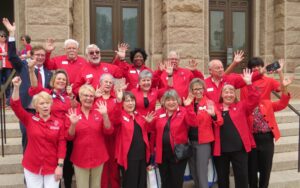This past Sunday (February 5), the Houston Chronicle ran a guest column by Bill King suggesting that public pension plans in Texas are facing a crisis. As you have read in two recent TRTA news bulletins, it is our position that TRS Texas is not in crisis. In an effort to defend your Teacher Retirement System, TRTA Immediate Past President Dora Scott-Nichols and TRTA Executive Director Tim Lee sent letters to the Houston Chronicle in response to Sunday’s column. These letters are provided for your information. We have also provided this link to the original article written by Mr. King.
Please let your friends, family, and fellow public education retirees know that TRTA is fighting to protect your TRS pension plan. We will not rest, and we will do all we can to protect and improve your TRS traditional retirement benefit. Thank you for your support and continued membership in TRTA. If you are not a member and would like to join in our collective effort, please contact the TRTA at 1.800.880.1650.
Response to Bill King Column by Dora Scott-Nichols, TRTA Immediate Past President
TRS is the Great Texas Legacy
Mr. Bill King wrote an article about the crisis the state is facing with its public pension plans. I was glad to read that he is urging people not to generalize these plans, as they are all different. I am concerned that Mr. King’s focus seems to be the Teacher Retirement System of Texas (TRS). I want to set the record straight.
TRS Texas is one of the best-funded and well-managed pension plans in the world. In its 75 year history, TRS has earned billions of dollars, provided retirement security to millions of Texans, invested in many Texas private businesses, never missed an annuity payment to a single TRS retiree, provided Texans with thousands of private-sector jobs, and offered a great incentive to recruit and retain the best educators.
Attacking TRS for being underfunded shows a misrepresentation of the facts, or a lack of understanding about how pension funds are managed. TRS can account for $.83 of every dollar needed to pay benefits promised to all of its members, retired and active. Keep in mind that the taxpayer contribution to make up for this difference is far less than Mr. King suggested in his article. The other $.17 will be accounted for over the course of an active employee’s career through contributions and earnings on investments. This is referred to as the overall funded status of a pension fund. It is a widely accepted fact that public pension plans operating with a funded status of 80% or more are in very good fiscal health.
TRS has been in better fiscal health in years past. Mr. King correctly pointed out in his article that many of the funding concerns have come about within the last 10 years. In this timeframe, the country has suffered through two deep recessions and major world economic transitions. TRS had some down investment years. As a matter of fact, in February 2009 the pension fund’s value was about 67%. Since then, the fund has gained back billions of dollars and restored its overall fiscal health to nearly 83%. Last fiscal year alone, TRS earned more than $15 billion on its investment portfolio. There is still much work to do, but TRS and the Texas Legislature have taken a steady and thoughtful approach to keeping the TRS fund on strong financial footing.
Managing a $100-plus billion pension fund is not an easy task. There are professionals hired by TRS to make the decisions necessary to grow the pension fund assets. The professionals at TRS are truly behind-the-scenes heroes. Unlike Mr. King’s portrayal of “pension bureaucrats, fund managers, lawyers, and accountants,” the TRS professional team manages the fund at a cost of about $43 per year per member! Try and find any fund management team in the private sector that that will manage a retirement plan for an annual rate of less than $50 per investor per year. TRS is a world-class institutional investor managing the retirement security of over a million Texans at a much lower cost and at a much higher level of service than just about any private sector fund manager in the country.
This does bring about the other side of Mr. King’s statement. That is, if the state “transitioned” active and future public educators out of the TRS defined benefit plan, to where would they be transitioned? The answer is private sector money managers, lawyers, and accountants. To make the assertion that fund managers, lawyers, and accountants would be completely eliminated from the retirement planning picture if we move public educators out of TRS and into a private sector model is ridiculous. These money managers are reveling in the possibility of a mass migration of business away from the TRS traditional defined benefit plan to a defined contribution plan. Yes, there is far more money to be made off active school employees if they were kicked out of their defined benefit plan that manages these assets at such a low cost.
Cost efficiencies and the professional management of trust fund assets are critical to a defined benefit public pension plan. But, Mr. King’s article brings up another interesting idea: the private sector’s abandoning of the traditional retirement model and the growth of the defined contribution model. One of the elements of the defined contribution model is the reliance on the federal Social Security program as the basis of an individual’s retirement security. The defined contribution model, unlike the defined benefit model, makes no implicit or explicit guarantee of retirement income. The DC model is designed to complement a person’s retirement income; an income that generally includes Social Security.
Most Texas public educators do not participate in Social Security. While this may seem odd to some, the fact is that TRS dates back to a time when individual states could opt in or out of the federal program. Today, over 800,000 active school employees and thousands of current retirees do not have Social Security coverage. Freezing or eliminating the TRS defined benefit plan would almost certainly guarantee the federal government “mandating” these employees be covered by Social Security. This “mandatory Social Security” is an issue being debated in Washington, D.C. even today. This would be a huge hit on the taxpayer’s pocketbook and a real loss to all Texans. The transition cost to Social Security may cost hundreds of millions of dollars with no real gain to show.
The only other alternative to this scenario is worse: tell our public school employees they will not have a traditional retirement plan or Social Security, and that they must manage a retirement plan with no safety net at all! At least one other group advocating for the elimination of TRS has suggested such a course. We cannot allow this foolishness to take a foothold in Texas! Doing so would be a disincentive for anyone considering becoming a professional educator, as it would be a road to future poverty and true retirement insecurity.
Much more could be said in the defense of the TRS traditional retirement plan. The plan, though, is not in crisis. It is operating very efficiently and is providing retirement security to 1 out of every 21 Texans. It provides a good benefit at a reasonable cost. It has done so for 75 years. It can continue to do so for another 75 years as long as we continue to meet our funding obligations, review the benefit structure, make sound investment decisions, and work together as a state to ensure this plan is not subjugated to the fiery rhetoric that is hammering public educators and employees in other states. Yes, we have some challenges to meet in the coming years. The solutions to those challenges can make the fund stronger without eliminating a traditional defined benefit plan that is a proven success.
TRTA Response to Bill King Guest Column in Houston Chronicle by Tim Lee, Executive Director Texas Retired Teachers Association
TRTA Response to Bill King
By Tim Lee, Executive Director, TRTA
As Executive Director of the Texas Retired Teachers Association (TRTA), I am compelled to respond to Mr. King’s opinion piece in the Houston Chronicle on February 5. While I cannot speak to the financial condition of the Houston municipal pension plans, I will speak to the great legacy and fiscal expertise of the Teacher Retirement System of Texas (TRS).
TRS is the sixth largest pension fund in the nation, the 20th largest fund in the world, and the second highest return-seeking fund in the state of Texas after only Exxon. I agree with Mr. King that improvements can and should be made to the fund, beginning with a state contribution that enhances the fund’s expert ability to earn investment returns. 60% of the TRS fund consists of investment earnings. In a typical day, the trust is expected to grow by $40 million.
Mr. King states that TRS is $32 billion underfunded. The most recent valuation of TRS shows a funding level of 82% with an unfunded actuarial liability of $24.062 billion. 82% does not meet the Texas statute that determines when cost-of-living adjustments can be granted from the fund (Section 821.006). While this law has prevented public education retirees from receiving a benefit increase for 11 years, it also protects the fund’s long-term financial health.
But what exactly would it take to make TRS actuarially sound? According to TRS, the Texas Legislature would have to fund TRS at the actuarially required contribution or ARC. The Texas Constitution provides that the state contribute no less than 6% and no more than 10% of the aggregate active teacher payroll to TRS. In 2012, the state’s contribution is at the constitutional minimum of 6%, down from 6.644% in 2011. The suggested ARC is 8.13%. This means that if the state were to contribute that amount this year, TRS would be able to fund its liabilities within 31 years and would meet the statutory definition of actuarial soundness TODAY. Then, a pension increase could be considered for TRS retirees.
This is dependent upon investment gains and losses, and assumes a rate of 8% for the year (the average 25 year rate of return for TRS is 9.2%). If TRS experiences a higher return, the ARC would go down. Contributions to TRS account for only 2% of the state’s budget. Increasing the state’s contribution to 8.13% would utilize less than 2.5%. The burden on Texas taxpayers is overstated drastically by Mr. King. It is worth noting that public education employees in Texas contribute 6.4% of their salaries, which is more than the state’s contribution!
According to the National Institute on Retirement Security, “each $1 in taxpayer contributions to Texas’s state and local pension plans supported $8.32 in total output in the state. This reflects the fact that taxpayer contributions are a minor source of financing for retirement benefits – investment earnings and employee contributions finance the lion’s share.”
When the private sector abandoned the defined benefit plan, one of the primary motivators was to allow for increased mobility of the workforce. In Texas, mobility in the education field is discouraged in favor of experienced, dedicated educators. Corporations are also able to offer incentives to employees such as stock, and rely heavily on a combination of Social Security and defined contribution plans.
Texas is unique in comparison to other states due in part to the fact that 95% of our school districts do not pay into Social Security. TRS is the primary retirement income for over 300,000 Texans, 80% of whom receive no Social Security benefits at all. This is due to two federal provisions known as the Government Pension Offset (GPO) and Windfall Elimination Provision (WEP). Stated plainly, eliminating the defined benefit plan for public education retirees is the equivalent of eliminating their retirement security entirely.
The retirement security for private sector retirees is questionable. Among early Baby Boomers, 35% are at risk of being unable to maintain their standard of living after they stop working. This number increases to 49% for those with defined contribution plans. Americans with DB plans are much more likely to achieve financial security, with only 15% being at risk. Following the private sector lead on eliminating defined benefit plans does not have much merit.
TRS is a well-managed, financially sound fund. It earns far better investment returns than any individual 401k-style plan, and at a much lesser cost. The level of money management expertise at TRS costs an average of $40 per member per year. Finding a private sector financial planner willing to work for $40 per year per client who can earn more than 15.5%, which TRS earned in 2011 may be a futile effort. It is naïve to believe that private money managers would not earn more than $275 million from 1.3 million potential clients; the amount Mr. King states TRS spent on both administrative and investment expenses in 2011. Taxpayers should also note that all TRS administrative expenses are authorized by the legislature, but are actually paid for by the earnings off the fund! Even though there is a statutory requirement for the state to pay for these administrative costs, no tax dollars are allocated to TRS administration.
Simple, effective adjustments can strengthen the TRS fund and make its retirees eligible for a pension increase. These changes must take place at the state level. It is not necessary nor is it wise to transition TRS into a defined contribution plan, a costly endeavor that eliminates the retirement security of our dedicated educators and school personnel. The best way that Texas can live up to the promises made to our education force is to enact moderate increases in state contributions and maintain commitment to financial soundness.
Link to original article appearing Sunday, February 5
TRTA Contact Information
Toll-free: 1.800.880.1650 www.trta.org
Media Questions: Tim Lee, Executive Director (tim@trta.org) or Cindee Sharp, Government Relations and Outreach Specialist (cindee@trta.org)
Membership Questions: Brenda Hoisager, Membership Specialist (brenda@trta.org)



